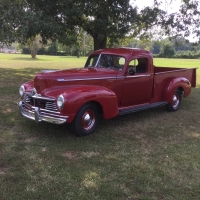Front wheel seals on ‘47 Hudson pickup
Hello all. I’ve been a member of the HET club for almost 25 years, but this is my first post here, so I hope I’m not asking for something that has been discussed many times.
I am in the process of reviving my ‘47 pickup. I fully restored it to original over 20 years ago (AACA First Junior in ‘98). It’s been in a corner of my shop undriven pretty much since. I’m now going through it to make it roadworthy and safe and maybe sell.
When I pulled the front drums to check the brakes, both front wheel seals were damaged. Both were National number 482253. Is that number correct for ‘47 pickups? The seals are available locally, but I wanted to ask here before I bought them.
I just attached the picture to show what things look like inside the drum
Thanks in advance. Tom
I am in the process of reviving my ‘47 pickup. I fully restored it to original over 20 years ago (AACA First Junior in ‘98). It’s been in a corner of my shop undriven pretty much since. I’m now going through it to make it roadworthy and safe and maybe sell.
When I pulled the front drums to check the brakes, both front wheel seals were damaged. Both were National number 482253. Is that number correct for ‘47 pickups? The seals are available locally, but I wanted to ask here before I bought them.
I just attached the picture to show what things look like inside the drum
Thanks in advance. Tom
0
Comments
-
Tom, my reference says NAPA 16347 is good.
0 -
Hi Park. Thanks for your response, but It seems that NAPA has either changed the part number or no longer carries that seal as two NAPA stores told me today that number 16347 was not valid.
I went to the go-to bearing supplier in Shreveport today (right next door to one of the NAPAs) and all they had that matched the OD and ID of the seal I took out was a Timken number 15635 seal that is about 50 thousands thicker than the National 482253. I bought a couple of them but when I pressed the first one in, the rubber lip was squashed against the back of the bearing and if I had attempted to install the drum on the spindle, the lip would have sheared off
I’m still on the hunt.
Tom0 -
An update—- I quoted the wrong Timken number (15635) in my last post. I was not in my garage to look at the actual seal when I wrote the post, but was working off the bearing supplier’s invoice. The actual Timken (National) number is 473229.
When I installed one the first time as described above, I used a flat plate of steel and pressed the seal down flush with the hub.
I thought about that that a bit, and realized that if I didn’t press the seal in to where the lip was squashed the seal could still function as designed as long as the flat side of the seal didn’t rub on the spindle. As shown in the picture, the seal now protrudes from the hub about .100”. Because this seal is about .050 thicker than the one that was in there before, there is plenty of contact surface to hold it in place in the hub.
I mounted the hub on the spindle and spun it around quite a bit. I took it apart again and checked the flat side of the seal for rub marks. There were none, so I think I’m good to go.
Tom0
Categories
- 36.9K All Categories
- 112 Hudson 1916 - 1929
- 20 Upcoming Events
- 92 Essex Super 6
- 28.6K HUDSON
- 571 "How To" - Skills, mechanical and other wise
- 995 Street Rods
- 151 American Motors
- 178 The Flathead Forum
- 49 Manuals, etc,.
- 78 Hudson 8
- 44 FORUM - Instructions and Tips on using the forum
- 2.8K CLASSIFIEDS
- 608 Vehicles
- 2.1K Parts & Pieces
- 77 Literature & Memorabilia
- Hudson 1916 - 1929 Yahoo Groups Archived Photos

